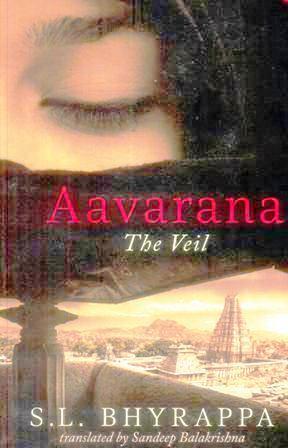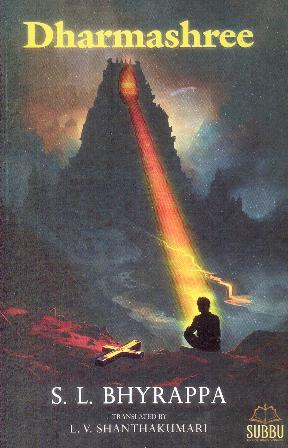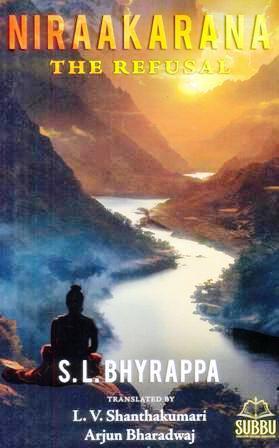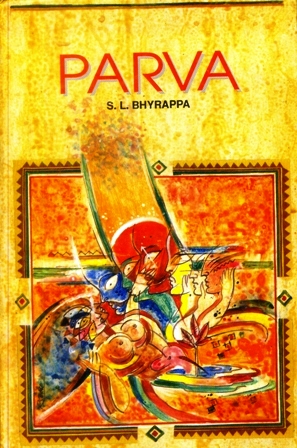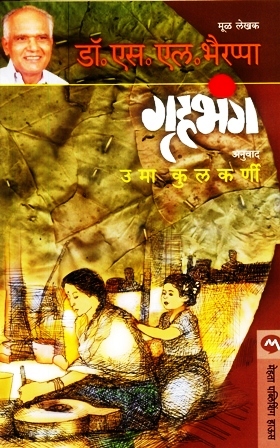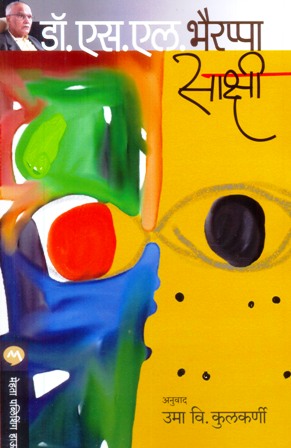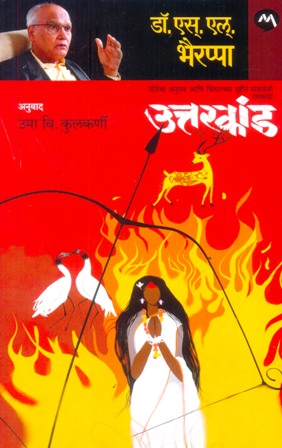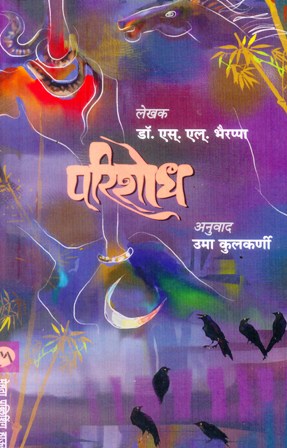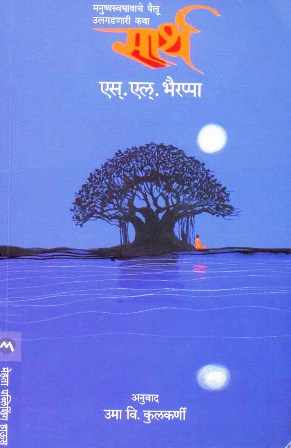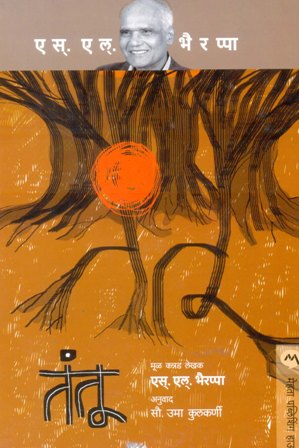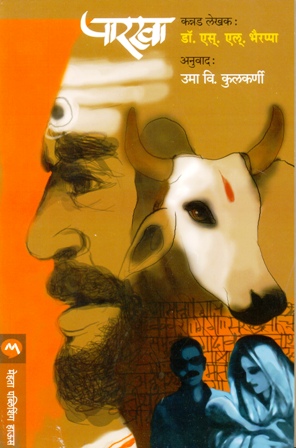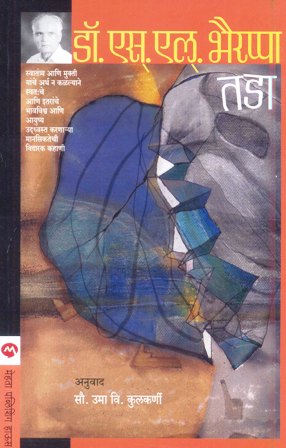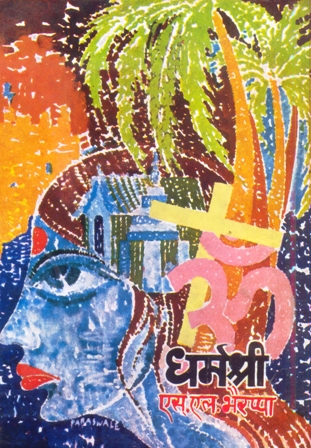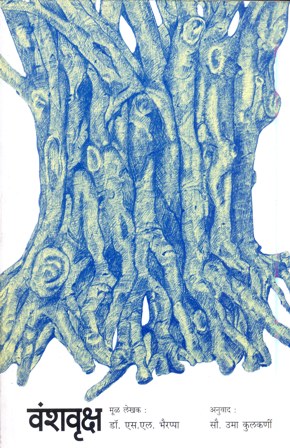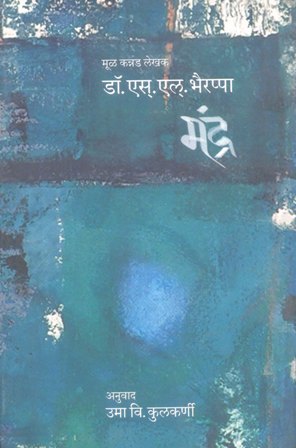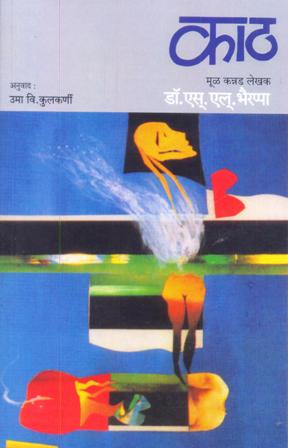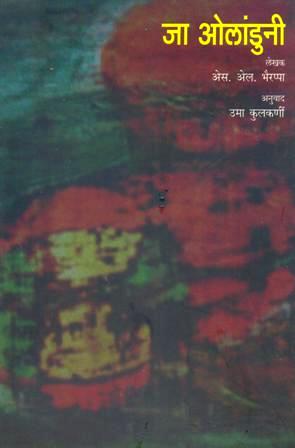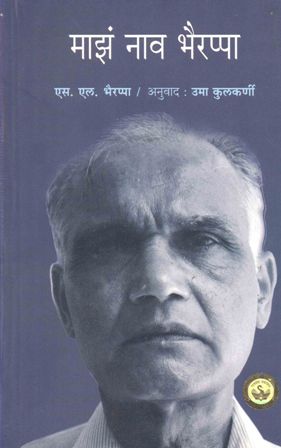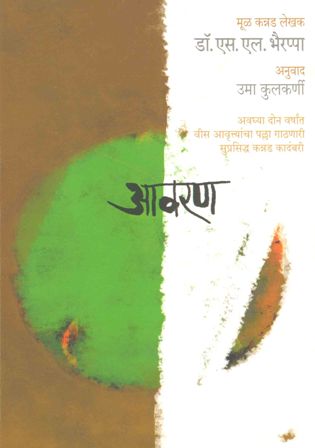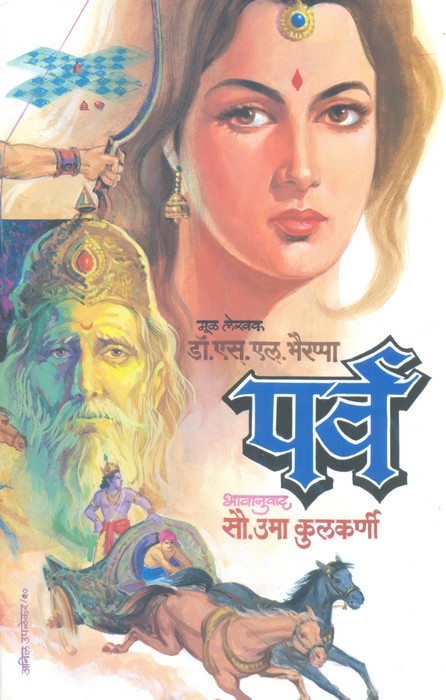-
Aavarana The Veil
Because my questions made Amir uncomfortable, he pronounced talaq just like that on the wife who had abandoned everything for him because his religion gives him that privilege. Where do I now stand, sir? Do you have any solutions for me?' Lakshmi, a rebellious, free-spirited and intelligent film-maker, breaks ties with her staunchly Gandhi an father to marry Amir, the man she loves. She even agrees reluctantly to Amir's request that she convert to Islam, as a formality and change her name to Razia. However, she is shocked to discover that her husband is not the open-minded, progressive individual he claimed to be. For after marriage, Amir takes his family's side in trying to force her to follow the more rigorous tenets of their faith. This sets her off on a personal journey into India's history to uncover the many layers of religion, caste and creed. Her quest leads her to the many parallels in the narratives between the past and the present and she gradually finds that though much has changed in Indian society over the centuries, much remains the same. The second historical novel by celebrated Kannada author S.L. Bhyrappa, translated for the first time into English by Sandeep Balakrishna, Aavarana: The Veil raises pertinent and searching questions about religion, liberalism and identity and highlights the importance of unshackling oneself from the bonds of false knowledge. Book Features: Raises questions and uncovers truths about religion and historyGoes deep into history to reveal the extent of tyranny by foreign invaders in IndiaWas a bestseller in Kannada, Gujarati, Tamil and other vernacular languagesThe Kannada version was sold out even before its release in February 2007. It went into 10reprints within 5 months of its release
-
Dharmashree
Composed in the early phase of Dr. S L Bhyrappa’s literary career, Dharmashree (1961) deals with the evils of religious conversion and the trauma it causes—at the levels of the individual, family, and society. The subtle and nefarious attempts of Christian missionaries and their relentless attempts at undermining Hinduism for the sake of proselytization are vividly brought out in this novel. Dharmashree depicts the episodes in the life of Satyanarayana, a staunch adherent of Sanātana-dharma, who ends up falling in love with a Christian girl, Lily. Initially a harsh critic of Hinduism, Lily is deeply influenced by Hindu ideals as she wades past discussions and arguments with Satya. Lily’s father would never marry her off to a non-Christian, so what does Satya do? The issues that Bhyrappa raises in this work—authored over sixty years ago—continues to be relevant because even today, thousands of Hindus are getting converted to other religions, creating a rift in their families and the society. The English translation of Dharmashree has been undertaken by Prof. L. V. Shanthakumari, a renowned scholar, literary critic, creative writer, and translator.
-
Niraakarana
Narahari, a widower and the father of five, decides to give away his children for adoption. He craves for solitude and finds it impossible to participate in the mundane world. He is drawn towards saṃnyāsa and is allured by the heights scaled by realised souls like Bārāmāsi Mahārāj. He treks the Himalayan peaks, but… can he freeze his mind at a place where time and space are frozen? Can he swim against the river of life to reach its source? Does physical altitude translate to spiritual altitude as well? India’s foremost novelist, Padma Bhushan S. L. Bhyrappa explores the attractions and aversions that humans feel towards worldly life in Niraakarana – The Refusal. He lays bare the dilemmas that a person faces at various stages of his life and the repercussions his decisions can have on his immediate family. The novel creatively suggests the true nature of renunciation and the kind of forbearance it demands. The English rendition of this emotionally engrossing and spiritually uplifting saga retains the nuances of the Kannada original. It has been admirably translated by L. V. Shanthakumari and Arjun Bharadwaj, award-winning authors and translators in their own right with many books to their credit.
-
Parva
The novel narrates the story of the Hindu epic Mahabharata mostly using monologue as a literary technique. Several principal characters found in the original Mahabharata reminisce almost their entire lives. Both the setting and the context for the reminiscence is the onset of the Kurukshetra War. Parva is acknowledged to be S.L.Bhyrappa's greatest work.Non-Kannadigas who have read it in it's Hindi and Marathi translations consider it one of the masterpieces of modern Indian literature.It is a transformation of an ancient legend into a modern novel.In this process,it has gained rational credibility and a human perspective.The main incident,the Bharata war,symbolic of the birthpangs of a new world-order,depicts a heroic but vain effort to arrest the disintegration and continue the prevailing order.It is viewed from the stand points of the partisan participants and judged with reference to the objective understanding of Krishna.Narration,dialogue, monologue and comment all are employed for it's presentation.Shot through with irony,pity and understanding objectivity,the novel ends with the true tragic vision of faith in life and hope for mankind. Parva has been translated into the following major Indian languages; Bengali, Hindi, Marathi, Tamil and Telugu apart from English. The novel narrates the story of the Hindu epic Mahabharata mostly using monologue as a literary technique. Several principal characters found in the original Mahabharata reminisce almost their entire lives. Both the setting and the context for the reminiscence is the onset of the Kurukshetra War
-
Gruhabhang (गृहभंग)
गृहभंग ही स्वातंत्र्यपूर्व भारतात 1920 ते 1940 सालादरम्यान घडणारी कादंबरी. याचं कथासूत्र एका चारी बाजूंनी समस्यांनी ग्रासलेल्या महिलेच्या, नंजम्माच्या संघर्षाभोवती फिरतं. मूर्ख नवरा, खाष्ट सासू, अंधश्रद्धाळू शेजार आणि भीषण गरिबी अशी ओढाताण सहन करत नंजम्माचा जीवनसंघर्ष सुरू आहे. नंजम्माची सासू प्रत्येक दुर्दैवाला नंजम्माला जबाबदार धरते. नवरा घरची जबाबदारी नाकारतो. अशात आपल्या निर्भेळ स्वभावानं आणि धैर्यानं नंजम्मा परिस्थितीवर मात करू पाहते. घरसंसार उभा करू पाहते. आत्मनिर्भरपणे उभं राहत असतानाच आपल्या मुलांना चांगलं आयुष्य आणि चांगले संस्कार देण्यास धडपडते. मानवी मनाच्या अतर्क्य व्यापारांमुळे आणि नियतीच्या घावांमुळे घायाळ झालेल्या नंजम्माची हदयाला पीळ पाडणारी कथा.
-
Sakshi. (साक्षी)
मानवी भावभावनांकडे अलिप्तपणे पाहिलं की आपल्या जाणिवांना खरे रुप गवसते. हा निरंतर संघर्ष या कादंबरीत परमेश्वरय्या यांच्या रूपाने अवतरला आहे. एका खोट्या साक्षीसाठी स्वतःला दोषी माननारे परमेश्वरय्या आत्महत्या करतात आणि यमसदनी पोहोचतात. पण त्यांना सूक्ष्मदेहाने पुन्हा पृथ्वीवर पाठवण्यात येत आणि त्यांचा भोवताल साक्षीभावाने पाहण्यास सांगितलं जातं. परमेश्वरय्यांचा हा प्रवास नकळत प्रत्येक मानवी मनात चाललेल्या संघर्षातं प्रतिनिधित्व करतो.
-
UTTARKAND (उत्तरकांड)
‘उत्तरकांड’ ही रामायणावर आधारित कादंबरी साकारली आहे सीतेच्या प्रथमपुरुषी निवेदनातून.. त्यामुळे रामायणातील घटना/प्रसंग तिच्या दृष्टिकोनातून उलगडतात. रामाची पत्नी म्हणून तिच्या वाट्याला जे भोग आले, त्याचं मनोविश्लेषणात्मक चित्रण या कादंबरीत केलं गेलं आहे. त्यामुळे राम-सीता-लक्ष्मणाबरोबरच रामायणातील अन्य व्यक्तिरेखाही पारंपरिक चौकट भेदताना दिसतात. सीतेच्या प्रथमपुरुषी निवेदनामुळे या कादंबरीत नाट्य निर्माण झालं आहे. या कादंबरीमुळे रामायणाचा एक नवा अन्वयार्थ समोर येतो.
-
Dharmashree (धर्मश्री)
तत्त्वज्ञान हे वेगवेगळ्या विचारशक्तीच्या माणसांमध्ये कशा वेगवेगळ्या प्रेरणा निर्माण करते आणि त्या प्रेरणा व्यक्तीच्या जीवनधारा कशा संपूर्ण बदलून टाकतात याचे दर्शन 'धर्मश्री' कादंबरीत स्पष्टपणे होते. जीवनाबद्दल प्रत्येकाला असलेली श्रद्धा व जीवनाची मूल्ये यांच्यातला संघर्ष व शेवटी निघणारे सत्य यांचा संगम 'धर्मश्री' मध्ये दिसून येतो. हा संगम तत्त्वज्ञानाच्या रुपाने वाहतो, पण कादंबरीची सुबोधता व सौंदर्य बिघडवून टाकत नाही. - विजयालक्ष्मी रेवणकर
-
Vanshvruksh ( वंशवृक्ष )
अपत्त्यावर पहिला अधिकार पित्याचा की मातेचा ? बीजाचा की क्षेत्राचा ? महाभारतात उद्भवलेला हा प्रश्न. डॉ. एस. एल. भैरप्पा यांनी मन्वंतर काळाची पार्श्वभूमी घेऊन या प्रश्नावर चर्चा केली आहे. वेदविद्यापारंगत श्रीनिवास श्रोत्री भागीरथम्मा - लक्ष्मी, इतिहास संशोधक सदाशिव - नागलक्ष्मी करुणारत्ने आणि साहित्याचा प्राध्यापक राज - कत्त्यायनी नंजुंड यांच्या नातेसंबंधांच्या पार्श्वभूमीवर जेव्हा हा प्रश्न कसाला लागतो तेव्हा भैरप्पांची प्रतिभा उच्च कोटीची रसनिष्पत्ती करते याचा अनुभव या कादंबरीत पानोपानी येतो. वंश सातत्त्याच्या कल्पनेला छेद देणारी कादंबरी. या कादंबरीला 1989 सालचा केंद्र साहित्य अकादमीचा 'अनुवाद पुरस्कार’ मिळाला आहे. त्यासाठी स्वातंत्र्योत्तर काळातील समग्र अनुवादांचा विचार केला गेला होता. डॉ. भैरप्पांच्या मूळ कादंबरीतली रसोत्कटता अनुवादातही जशीच्या तशी ठेवण्याचं कौशल्य सौ. उमा वि. कुलकर्णी यांचं !
-
Mandra (मंद्र)
किती तरी वेळानंतर भोसलेचा आवाज ऐकू आला, "कलेच्या क्षेत्रात यांनं आपल्याला स्वर्ग भेटवला ! पण कलाकाराच्या अंतरंगात डोकावलं तर तिथं वेगळंच असतं. का हा विरोधाभास ?" "मलाही हाच प्रश्न अनेकदा छळत असतो !" कुलकर्णी म्हणाले. कला आणि कलाकार यामधील अनाकलनीय नात्याचा परखड शोध... डॉ. एस.एल.भैरप्पा यांच्या प्रतिभासंपन्न नजरेतून !
-
Maza Nav Bhyrappa
एस. एल. भैरप्पा म्हणजे राष्ट्रीय स्तरावर नावाजले गेलेले आणि मराठी वाचकांमध्येही लोकप्रिय ठरलेले एक अग्रगण्य कानडी कादंबरीकार. मानवी नात्यांमधली गूढ गुंतागुंत उकलून दाखवणारे आणि अवघा जीवनसंघर्ष सप्तरंगांमध्ये चितारणारे प्रतिभावंत साहित्यिक म्हणून प्रसिद्ध असणार्या भैरप्पांचं हे प्रामाणिक आत्मचरित्र. जे जसं घडलं, ते तसं सांगणारं. नातेवाइकांपासून सहकार्यांपर्यंत सर्वांचीच - अगदी हितशत्रूंचीसुद्धा - आवर्जून दखल घेणारं. त्यांच्या आयुष्यातले आणि साहित्यिक जडणघडणीतले असंख्य चढउतार, यशापयश, सुखदुःखं... सारं काही वाचकांसमोर मांडून ठेवणारं. आत्मचरित्रांच्या दालनाची समृद्धी वाढवणारं एक पारदर्शी पुस्तक.
-
Parv (पर्व)
कर्नाटकातील अग्रगण्य कादंबरीकार तत्वचिंतक डॉ. एस. एल. भैरप्पा यांनी महाभारतावर लिहिलेली ही महाकादंबरी. यात मूळ महाभारतातील आभाळाएवढ्या उंचीच्या पात्रांचे वास्तव रूप रेखाटण्याचा प्रयत्न केला आहे. आधुनिक मानववंशशास्त्रीय, समाजशास्त्रीय संकल्पनेच्या प्रकाशझोतात महाभारताच्या व्यक्तिरेखांची संगती भैरप्पांनी लावली आहे. या कांदबरीमध्ये लेखकाने संज्ञा प्रवाहाचा फार मोठ्या प्रमाणावर वापर केला आहे. कादंबरीतील पात्रांच्या मनात येणारे विचार व्यक्त होता होता शेवटच्या एक दोन शब्दांबरोबर विचारांचा प्रवाह वेगळ्याच दिशेला वाहू लागतो. कुंती, भीष्म, द्रोणाचार्य यांच्यासारख्या दीर्घायुषी पात्रांच्या वाढत्या वयाचा 'फील’ देण्यासाठी त्यांच्या अवाढ्य आयुष्याला गवसणी घालण्यासाठी लेखकाने याचा अत्यंत चतुराईने आणि कलात्मकतेने वापर करून घेतला आहे. महाभारतातील दैवी चमत्कार, वर, शाप या गोष्टींना भैरप्पांनी संपूर्ण फाटा दिला आहे. व प्रत्येक घटना, प्रसंगांचा अत्यंत वस्तुनिष्ठ अर्थ लावून वेगळ्या दृष्टीकोनातून ही कथा मांडली आहे. आधुनिक समाजातील व्यक्तीस 'महाभारतातील व्यक्ती अशाच असल्या पाहिजेत’ असे या कादंबरीमुळे वाटू लागले. भैरप्पांनी शापांच्या, वरदानांच्या भक्कम पडद्याआड लपलेल्या माणसाचा घेतलेला शोध वाचकांना विचारप्रवण करणारा ठरला आहे. 'पर्व’ प्रसिद्ध झाल्यापासून या कादंबरीवर उलट सुलट अनेक चर्चा घडल्या, आरोप-प्रत्यारोप केले गेले. परंतू तरीही पर्व महाभारताची एक विलक्षण प्रत्ययकारी अनुभव देणारी कलाकृती ठरली.

